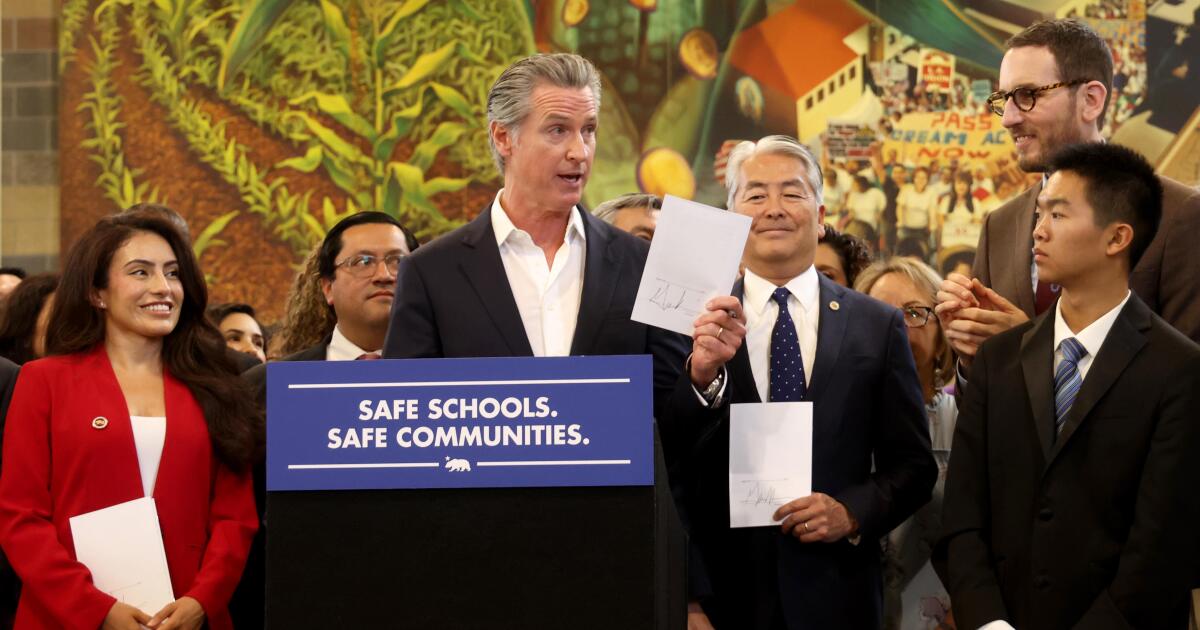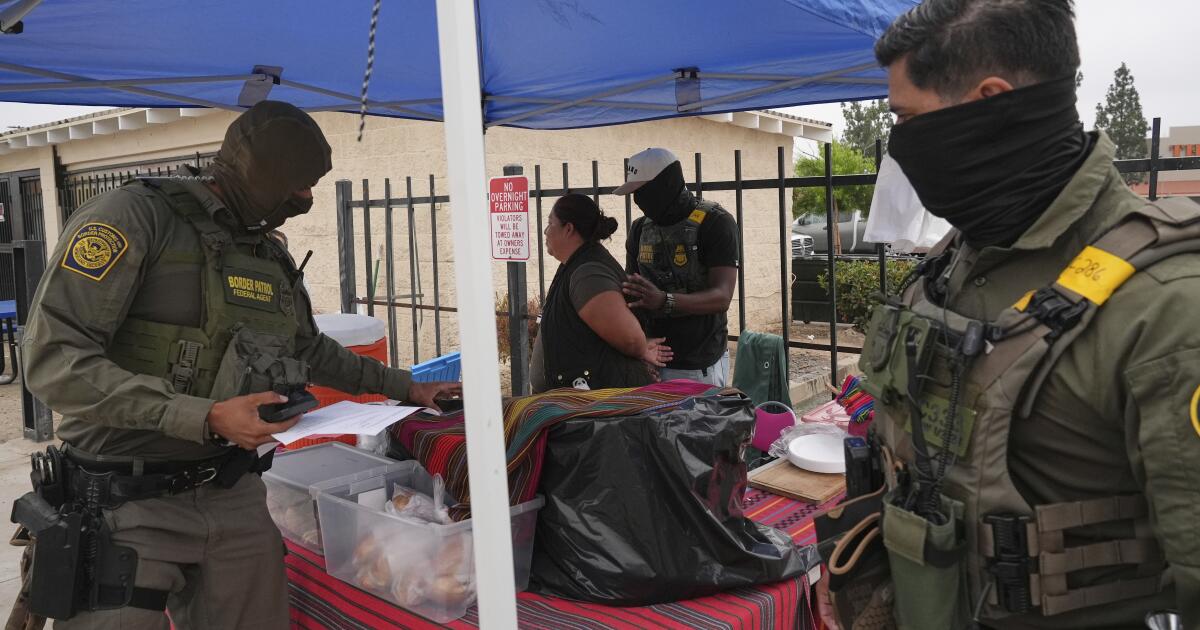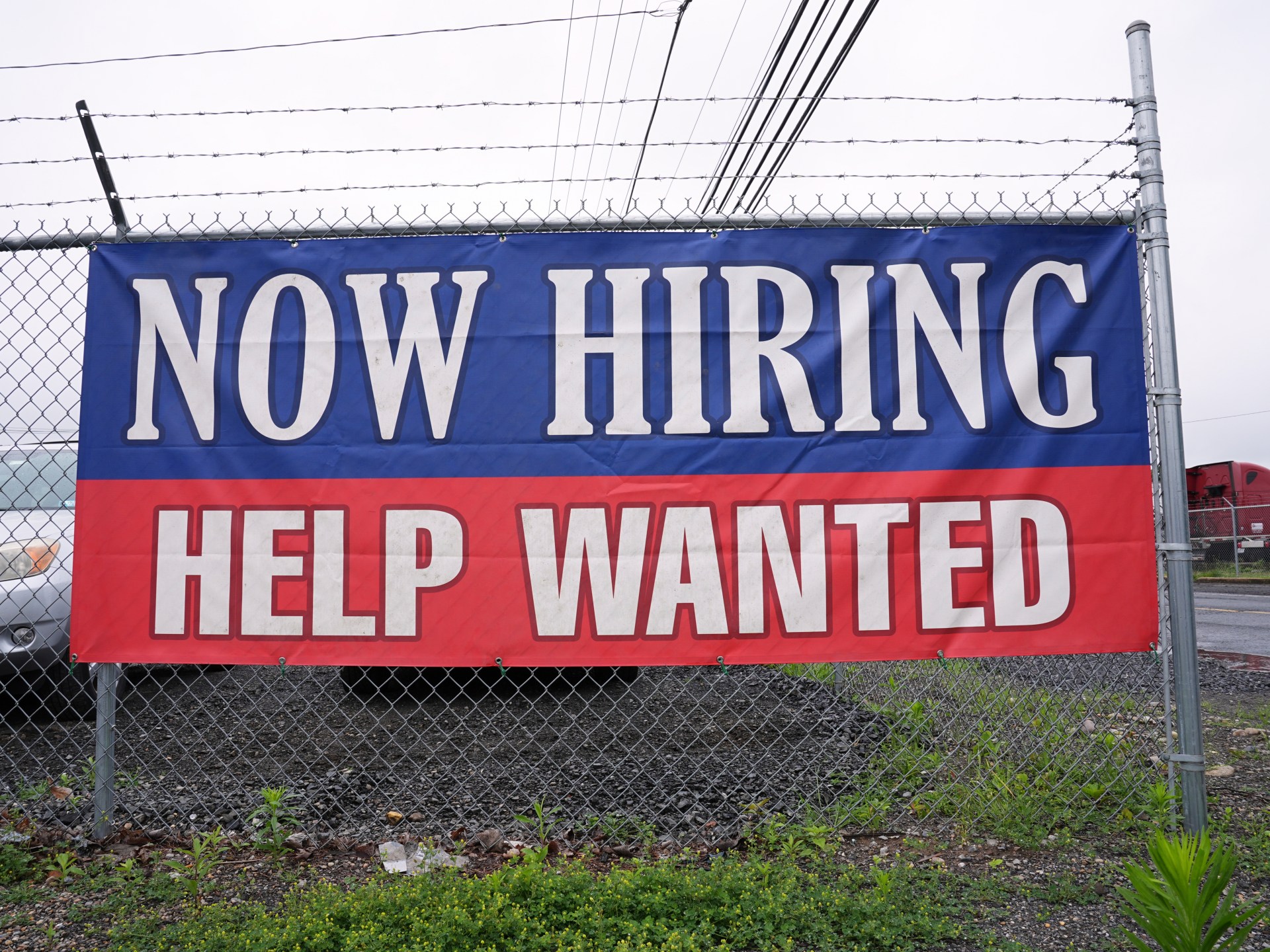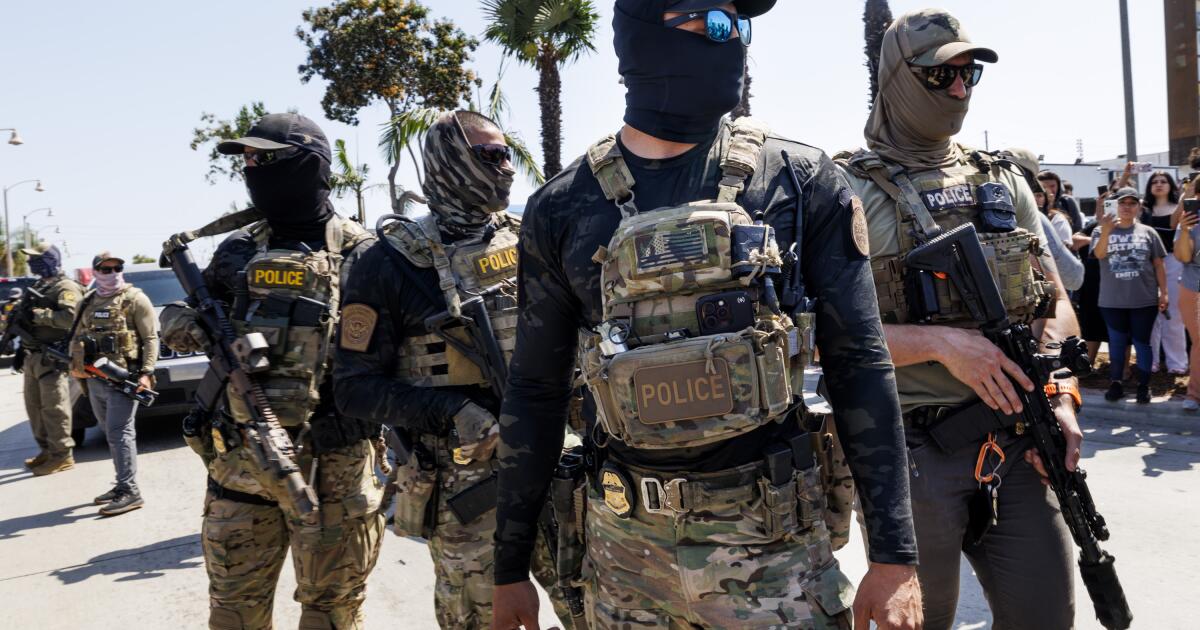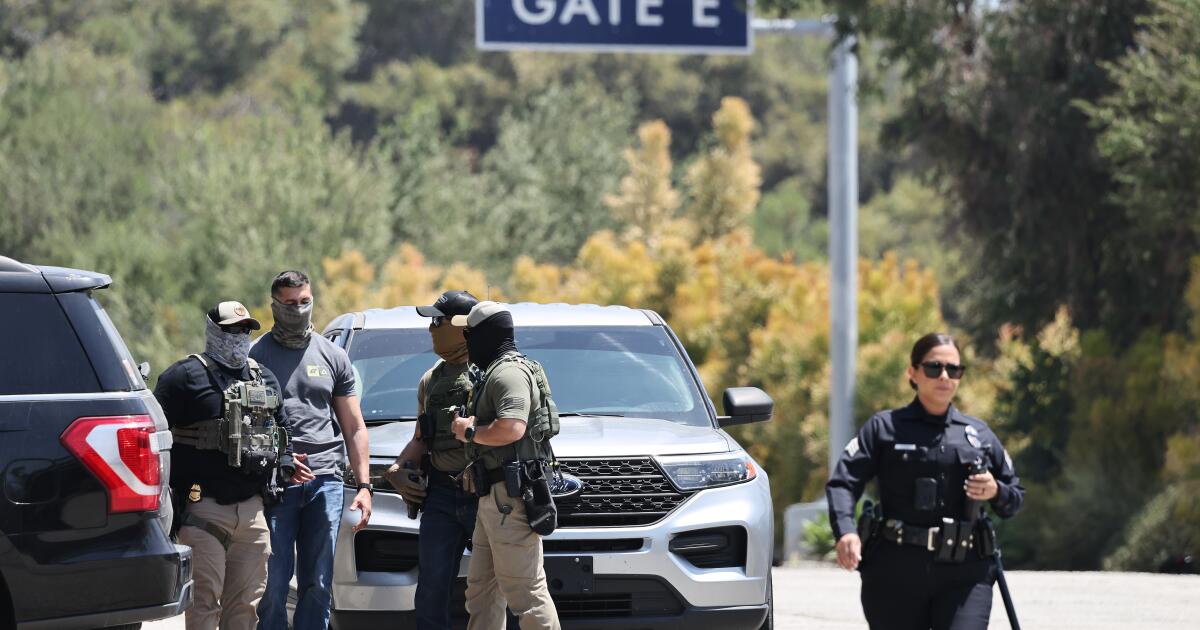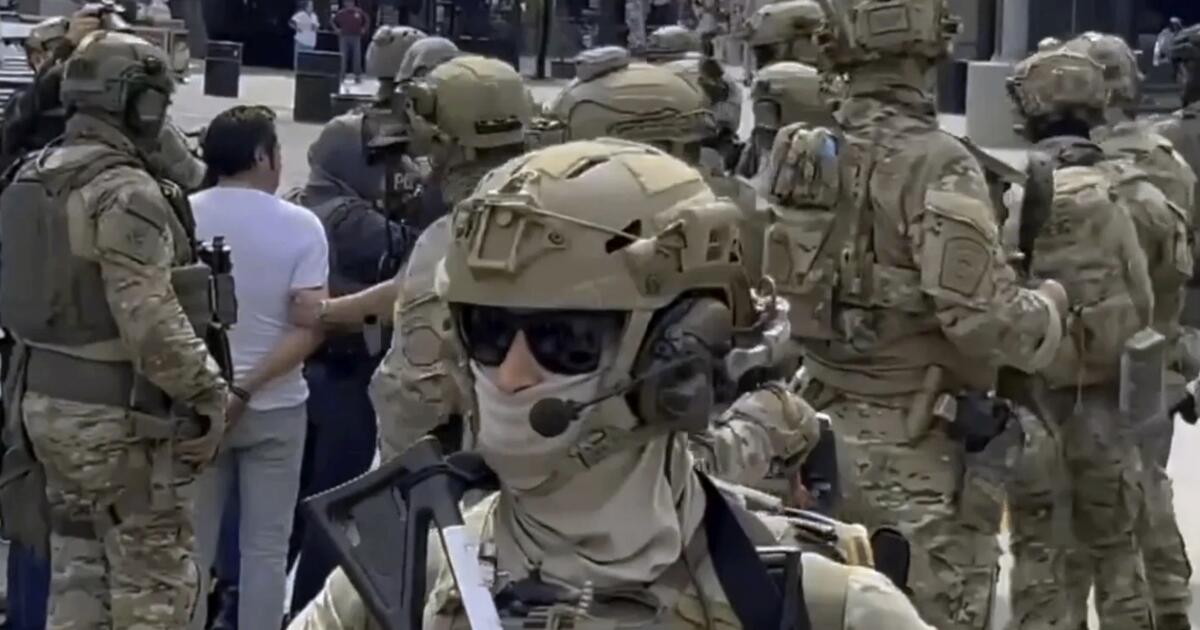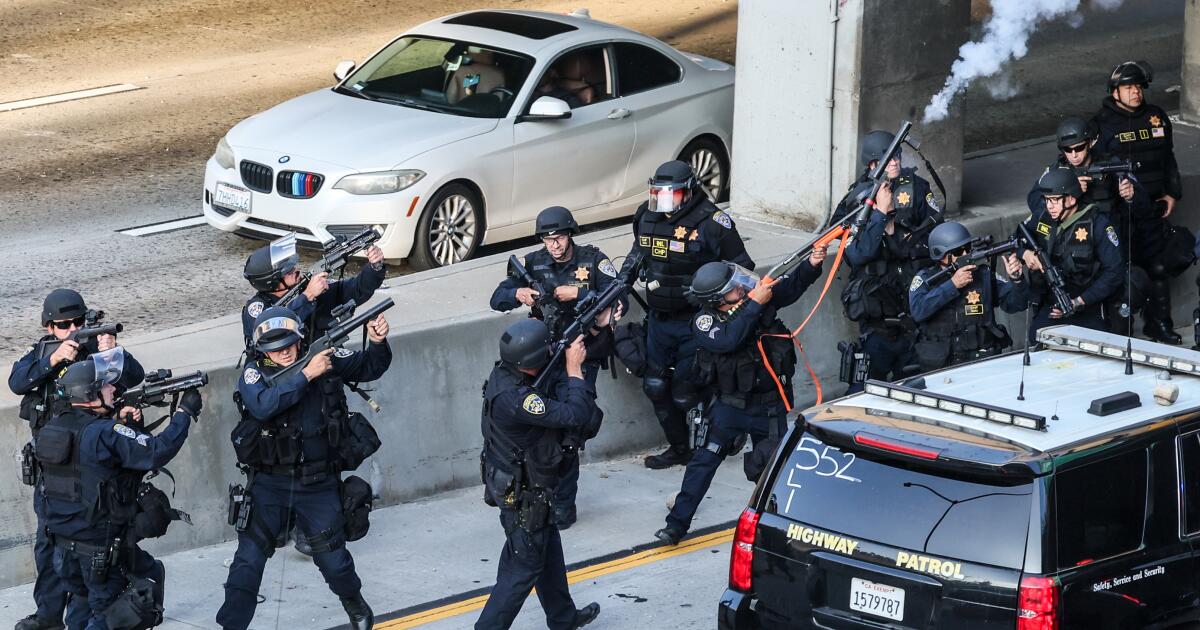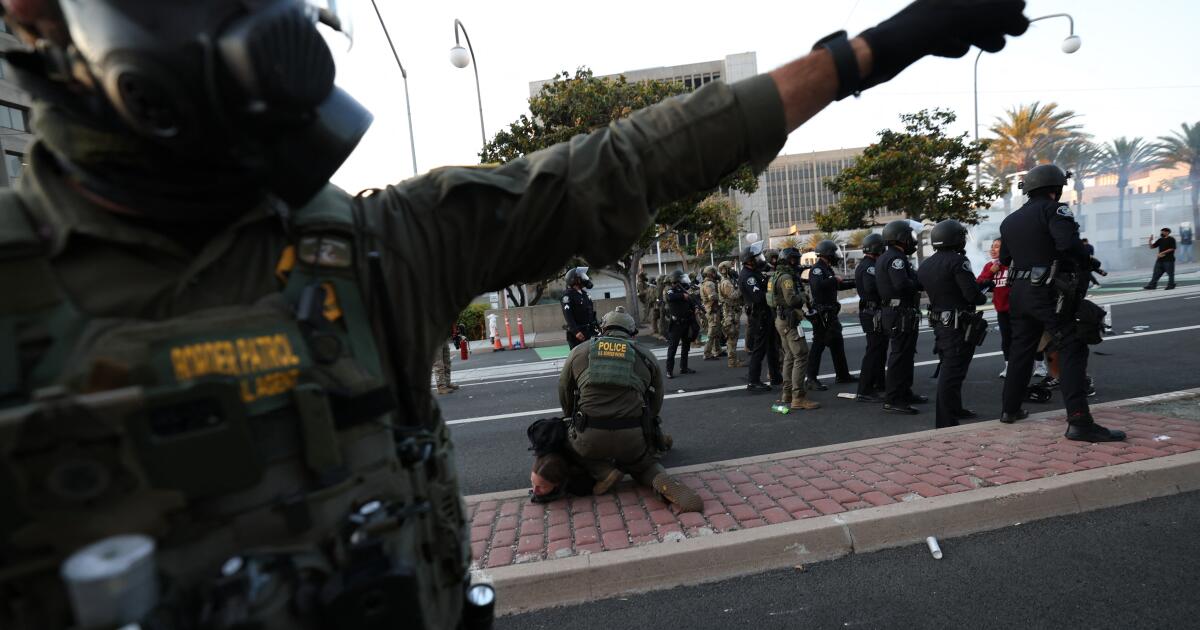I’ve watched two disturbing videos in the past day of federal authorities acting with frightening disregard for decency and democracy as they arrest immigrants.
At least, I think they are federal authorities. But these days, who knows?
The alleged officers detaining hundreds if not thousands of people each day in California and across the country are often masked. They sometimes refuse to answer questions, including which agency they represent. They threaten force — and even use it to make arrests of bystanders — when they are challenged.
In the first video I watched, a man in an unmarked car detains another man sitting on a bus bench in Pasadena. The man presumed to be a federal agent has on a vest that simply says “Police” and a cheap black ski mask that covers every bit of his face — the kind that looks like it was purchased on Amazon and that we have previously most associated with criminals such as robbers and rapists. A few of his colleagues are in the background, some also seemingly masked.
If these men approached me or one of my kids dressed like that, I would run. I would fight. I would certainly not take his word that he was “police” and had the right to force me into his car.
In the second video, another presumed federal agent jumps out of his unmarked vehicle and draws his weapon on a civilian attempting to take a photo of the license plate.
Yes — he points his gun at a civilian who is not threatening him or committing a crime. Folks, maybe you consider it a bad idea to try to photograph what may or may not be a legitimate police operation, but it is not illegal. This alleged officer appears to have simply not liked what was happening, and threatened to shoot the person upsetting him. The man taking the photo ran away, but what would have happened had he not?
These actions by alleged authorities are examples of impunity, and it is what happens when accountability is lost.
“It’s terrifying to be assaulted by people that you can’t be sure are law enforcement and who seem to be hiding their identity from you,” David Sklansky told me. He’s a law professor at Stanford and an expert on policing. He said there are times when secrecy by authorities can be justified, but it should be the exception, not the rule.
“The seizure of people by agents of the state who don’t identify themselves as agents of the state is a tool that has a long and ugly history of being used by authoritarian regimes,” he said.
ICE has claimed that its officers have a need and right to remain anonymous because threats and attacks against them have dramatically increased. The agency has been publicizing that its staff has seen a 413% increase in assaults against them, and that they and their families have been doxxed.
Speaking on the New York Times podcast “The Daily,” President Trump’s top border policy advisor, Tom Homan, said that his officers are doing the best they can under difficult circumstances.
“It’s not about intimidation,” Homan said. “ICE officers are wearing masks because they’ve been doxxed by the thousands. Their families have been doxxed. ICE officers’ pictures have shown up on trees and telephone poles. Death threats are sky-high. I know because I’ve been doxxed 1,000 times myself.”
You know what? I believe ICE officers are getting doxxed and threatened.
Any violent attack on law enforcement should be condemned.
And while we are at it, I don’t have any issue with deporting dangerous criminals. For today, I’m leaving aside the issue of whether Trump’s aggressive drive to deport people is good or bad. This isn’t about what is happening with these deportations, but about how authorities are exercising their power.
Threatening a law enforcement official is a crime. Doxxing is a crime. These agencies have the resources to track down, arrest and prosecute anyone who breaks those laws. They should absolutely do that.
Instead, federal authorities are hiding, apparently too frightened of online provocateurs and in-person hecklers to do their duty in plain sight.
But judges are being doxxed and don’t wear masks. Journalists are being doxxed and don’t wear masks. Politicians are being doxxed — and even killed — and are still doing their jobs out in the open. Which raises the question: Is it really not about intimidation?
“Quite frankly, I’ve had lots of guns pointed at me. I’ve had lots of threats against my life,” Lt. Diane Goldstein told me. “I never once wore a mask because I was afraid.”
Goldstein is the executive director of the Law Enforcement Action Partnership, a nonprofit composed of justice system authorities who advocate for better policies. She was also the first female lieutenant in the Redondo Beach Police Department, where she worked for more than 20 years, including on undercover assignments.
She points out that accountability demands some way to attach actions to individuals. Take that officer who pulled the gun on the license plate photographer.
“If one of my officers would have done that, I would have put him on an administrative leave, taken his gun away and initiated an internal affairs investigation,” she said. “There is no constitutional reason for him to jump out of a car and point a gun in that type of aggressive fashion at an ordinary citizen.”
However, we likely will never get to ask that officer what he was thinking — if he saw a threat that justified lethal force — because there is no easy way of identifying him. Forget who he is personally, we don’t even know what agency he is from.
“You have no idea if it’s the FBI, if it’s the DEA, if it’s ICE, if it’s CBP,” said Goldstein, rattling off the acronyms for various federal authorities. “There is no accountability and transparency.”
Sklansky points out that accountability doesn’t necessarily require a name or face. Although there is no law that requires it, federal authorities could simply put their badge number and agency name someplace visible. Voila! Accountability and safety for officers.
“Lots of law enforcement works this way,” he said.
Failing to provide any kind of trustworthy identification causes its own dangers, both Sklansky and Goldstein told me. People are required by law not to interfere with law enforcement doing their duty. But if you don’t know it’s law enforcement and fear you are witnessing an attack or are the victim of one, the situation is different.
Goldstein said that she worries about violence if bystanders think they are in the midst of a crime, or that local law enforcement will be called to intervene in what appears to be a kidnapping or assault.
“People can’t tell if they’re crooks or they’re law enforcement,” Goldstein said of officers who mask or hide their affiliation.
“Someone’s going to get hurt. A citizen is going to get hurt, a local cop is going to get hurt or a federal agent is going to get hurt. Their tactics are dangerous and putting the community in danger,” she said.
That fear that people are posing as law enforcement is real. Last week, a Minnesota legislator and her husband were killed by a gunman posing as a police officer. That same gunman earlier also went to the home of another politician and his wife and shot them as well, though they are expected to survive — their 28-year-old daughter called 911 after being shielded from the bullets by her mom.
The shooter banged on the front door of his victims, demanding to be let inside because he was law enforcement. Since then, articles are popping up, pointing out that people have a right to ask questions before just assuming that guy with the badge is really a cop.
After that attack, St. Cloud Police Chief Jeff Oxton sought to quell fears of fake cops roaming the streets by putting out a statement that stressed that it is “important that our public has confidence in the identification of our police officers.”
Of course it is important. In fact, it’s vital to democracy and public safety. The might of law derives from our trust in those empowered to enforce it, our willingness to respect their authority because it comes with both boundaries and responsibilities. The death of George Floyd and the protests that followed show just how tenuous, and how vital, that trust is.
An anonymous man in a ski mask does not inspire that trust, and does not deserve it.



